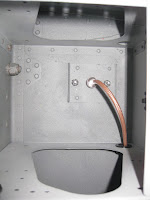Time to put the engine on.
I purchased a cheap Harbor Freight engine crane. This is just a welded box steel frame with a hydraulic press. So I was okay with buying it from Harbor Freight. The total was $139.61 after a sale and coupon (everything there has a coupon and is on sale - it's how they work). Assembly was quick (left) and I just had to test it (right).
I purchased a cheap Harbor Freight engine crane. This is just a welded box steel frame with a hydraulic press. So I was okay with buying it from Harbor Freight. The total was $139.61 after a sale and coupon (everything there has a coupon and is on sale - it's how they work). Assembly was quick (left) and I just had to test it (right).
The crane's legs could not be slid underneath the engine easily due to the latter resting on a pallet, so we used a 500 lb ratchet strap to slowly lift the engine out of its box at an angle.
Removal of the bag revealed a serious amount of desiccant.
The engine was then free to just chill out and hang.
Various fittings and the prop governor needed to be attached whilst the engine was strung up.
It's worth pointing out that the PT-030x1/4 tubing used to fabricate the Fuel Overflow Tube on page 43-05, Step 3 (shown on right), does not require a brass insert (as illustrated on 05-29, Figure 1, shown on left) like the smaller I.D. PT-062x1/4 brake lines. I confirmed this with Van's: "This assembly does not require a brass insert like what is needed for the brake lines." I suspect this may be due to the fluid exiting this tube not being under pressure, however I am not certain.
The Lord mounts are set on the FF-01400 Dyna-1 Tri-Gear Engine Mount. The durometers are placed differently between the upper and lower engine mount cups. They are oriented such that the weight of the engine puts the hard durometers in compression in positive G.
And finally the engine was lowered into place. However it was not a drop-in fit. It took some finagling. We also found that a third set of hands was useful. Especially if those hands are small so that the castellated nuts could be manipulated in the confined spaces they reside. We found that all bolts needed one additional washer to avoid bottoming out the threads.
Engine mounted.
Just for fun, here are the positions of the airframe before (top) and after (bottom) the engine was mounted. The weight of the engine and its contribution to the CG are apparent.
Update 14-Jan-17: Do not neglect to remove the expansion plug from the engine prior to mounting if you're using a c/s prop!




















































